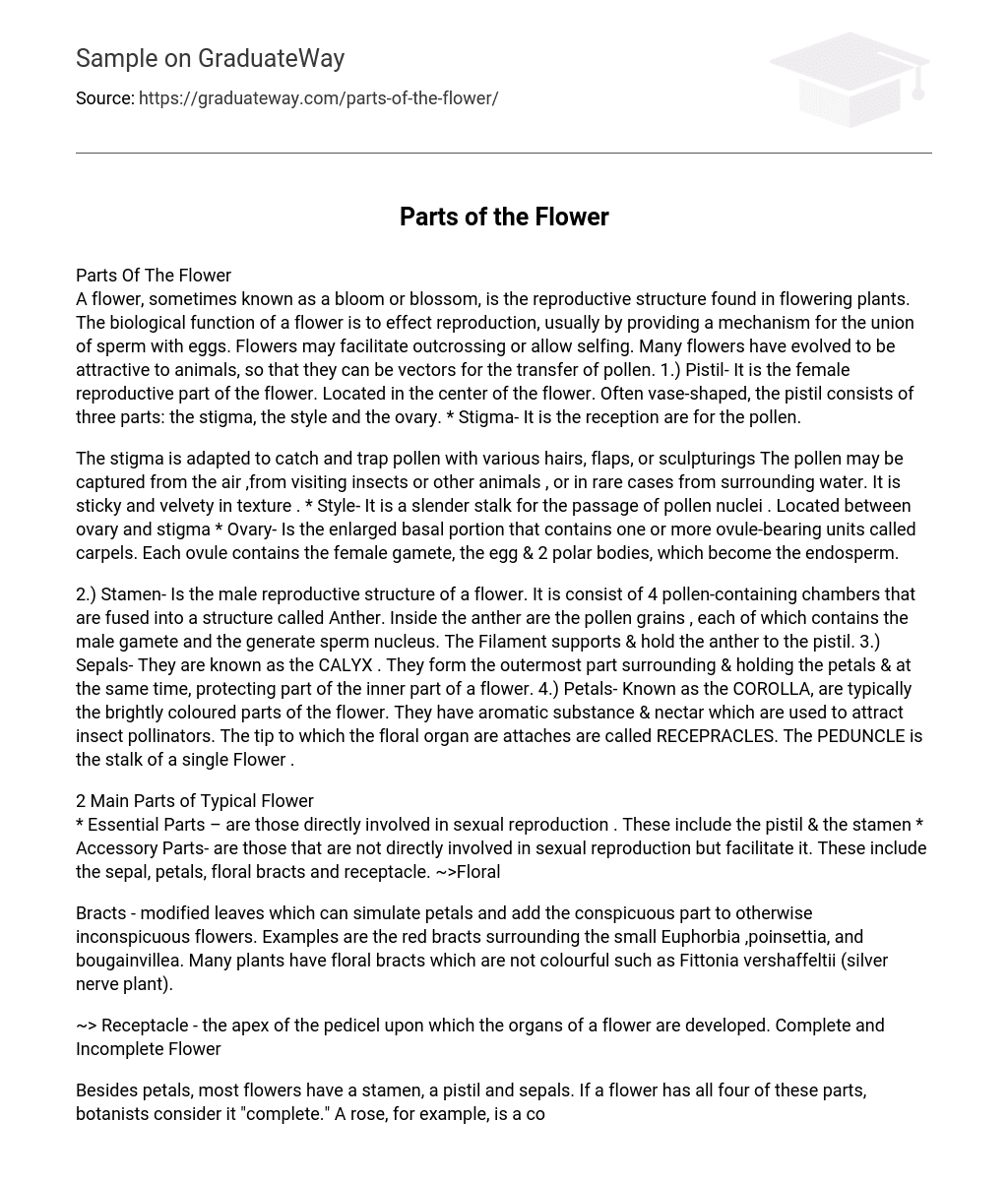Parts Of The Flower
A flower, sometimes known as a bloom or blossom, is the reproductive structure found in flowering plants. The biological function of a flower is to effect reproduction, usually by providing a mechanism for the union of sperm with eggs. Flowers may facilitate outcrossing or allow selfing. Many flowers have evolved to be attractive to animals, so that they can be vectors for the transfer of pollen. 1.) Pistil- It is the female reproductive part of the flower. Located in the center of the flower. Often vase-shaped, the pistil consists of three parts: the stigma, the style and the ovary. * Stigma- It is the reception are for the pollen.
The stigma is adapted to catch and trap pollen with various hairs, flaps, or sculpturings The pollen may be captured from the air ,from visiting insects or other animals , or in rare cases from surrounding water. It is sticky and velvety in texture . * Style- It is a slender stalk for the passage of pollen nuclei . Located between ovary and stigma * Ovary- Is the enlarged basal portion that contains one or more ovule-bearing units called carpels. Each ovule contains the female gamete, the egg & 2 polar bodies, which become the endosperm.
2.) Stamen- Is the male reproductive structure of a flower. It is consist of 4 pollen-containing chambers that are fused into a structure called Anther. Inside the anther are the pollen grains , each of which contains the male gamete and the generate sperm nucleus. The Filament supports & hold the anther to the pistil. 3.) Sepals- They are known as the CALYX . They form the outermost part surrounding & holding the petals & at the same time, protecting part of the inner part of a flower. 4.) Petals- Known as the COROLLA, are typically the brightly coloured parts of the flower. They have aromatic substance & nectar which are used to attract insect pollinators. The tip to which the floral organ are attaches are called RECEPRACLES. The PEDUNCLE is the stalk of a single Flower .
2 Main Parts of Typical Flower
* Essential Parts – are those directly involved in sexual reproduction . These include the pistil & the stamen * Accessory Parts- are those that are not directly involved in sexual reproduction but facilitate it. These include the sepal, petals, floral bracts and receptacle. ~>Floral
Bracts – modified leaves which can simulate petals and add the conspicuous part to otherwise inconspicuous flowers. Examples are the red bracts surrounding the small Euphorbia ,poinsettia, and bougainvillea. Many plants have floral bracts which are not colourful such as Fittonia vershaffeltii (silver nerve plant).
~> Receptacle – the apex of the pedicel upon which the organs of a flower are developed. Complete and Incomplete Flower
Besides petals, most flowers have a stamen, a pistil and sepals. If a flower has all four of these parts, botanists consider it “complete.” A rose, for example, is a complete flower. If one of these parts is missing, the flower is called “incomplete.” A begonia is an incomplete flower, because its flowers have either a stamen or a pistil, but not both.
Incomplete Flower
Complete Flower
Cherries Flower
Roses
Regular and Irregular Flower
* Regular flower is a flower with petals and sepals arranged around the center like the spokes of a wheel and that is thus radially symmetrical. * Irregular flower is a flower with petals that are not uniform in size or shape.
Irregular Flower
Daisy
Violet
Regular Flower
Nasturtium
Day Lillies
Zinnia
Perfect and Imperfect Flower
* Perfect flowers are flowers that have both Carpels (Female Organs) and Stamen (Male Organs). This enables them to perform self-pollination. * Imperfect Flowers are flowers that have either a carpel or stamen, but they cannot have both. Imperfect Flowers
Squash Flower
Begonia
Perfect Flower
Cratena religiosa
Tulip





